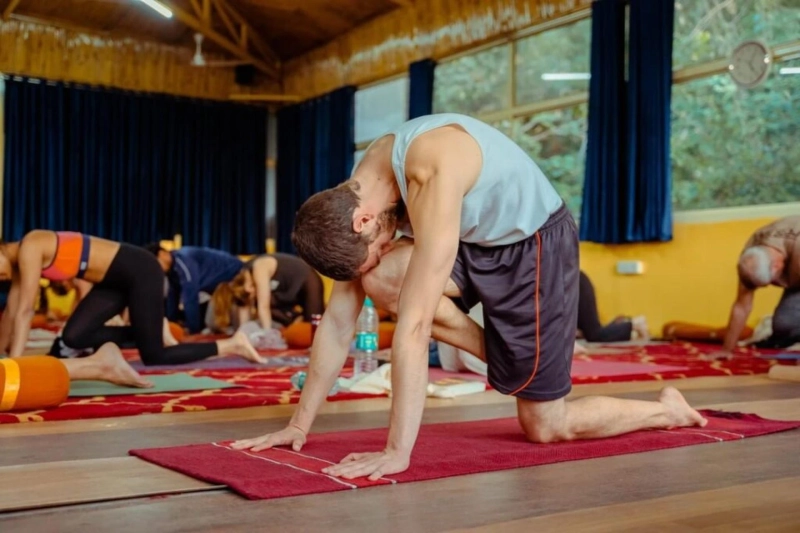Kakasana comes from the Sanskrit words “Kaka” which means “Crow” and “Asana” which means “Pose”. Kakasana is an intermediate level arm-balancing asana, which you can do after sufficient practice. You have to balance your whole body, on your wrists and arms. The main focus of the asana is on the biceps, triceps, forearms, wrist, palm, and core area. It is the 62nd pose in the 84 Hatha Yoga asanas. You can prepare yourself first, by doing arm strengthening exercises, to be able to balance the whole body on the arms and wrists.
This is a challenging pose, and once you manage to do it, your ego will definitely be satisfied. These are amongst the first arm balance postures that a student attempts. Postures like this help you to stay strong and flexible. Crow pose is a variation of Bakasana or Crane pose, where the only difference is that your arms rest against the upper arms in the former, and in the underarms in the latter. In order to get into either pose, you need to strengthen your abdomen and arms.
How To Do The Kakasana?
Kneel down on the floor and bring the big toes in contact with one another, as you sit on your heels. Once you start getting comfortable, spread your knees hip-width apart. You can also call it the squat position. Inhale and bend forward. After you are done, stick your torso between your thighs as you exhale.Now, contract the core muscles and the hip muscles, such that they point towards the navel. Raise yourself and settle down on the inner thighs.Stretch the tailbone away from the back of the pelvic bone, as you lift the base of your head slightly away from the back of the neck.Stretch your arms forward and place them in front of you in a manner that they are in line with your knees. Release your shoulder first, toward the floor. You should feel the weight of the front shoulders across your back.Hold the posture for 5-10 breaths.Tips To Practice Kakasana or Crow Pose
You need to warm up the wrists before you start attempting this posture. You need to keep the buttocks and heels together, when you raise the bottom part. When you are ready to lift yourself from the floor, push the upper arms against the shins. Draw the inner groin area into the pelvic cavity. The elbows tend to jut out when you are trying to balance yourself on your arms. That is completely wrong. You should try to keep the elbows in line with the shoulders and wrists. You need to move slowly through the pose. Do not be ready to wrap it up, as fast as possible. If you fear falling on your face, then you can place a cushion or blanket on the face.Modifications and Variations
Some students find it difficult to do these arm balance postures. In that case, you can start with deep squats with blocks. Crow pose and Crane pose are closely related to one another. So, you can try alternating between them. You can start the prep early on, by pressing your arms into the knees and knees into the arms. This will help in strengthening the body. You have to engage your ab muscles in the process. You can start with one leg as well. You can also start Crow pose with a block, placed beneath the feet. You can also start with the reclining Crow pose. Some yoga practitioners also start with chairs. You can use a bolster as well. You have to place the bolster in front of the face. Some yoga practitioners also start with the baby crow pose.There are a few asanas that will help in your prep. They are Balasana, Cat/ Cow pose, Lizard pose, Malasana, and the Staff pose. Keep practicing these, to make the transition easy.Benefits
If you practice this asana on a daily basis, the strength of your wrists and arms will increase slowly. It is a great full-body exercise. It also helps to strengthen both your shoulders. It also helps in contraction of the core muscles. It also stretches the abdominal muscles and opens the groin. The asana also stretches the muscles of the lower back. Your spine will also remain healthy if you practice this asana on a daily basis. Your abdominal organs also get a thorough massage, which leads to better digestion and relief from flatulence. You will feel happy if you do this asana on a regular basis. You need to maintain focus while doing the asana. The Crow pose promotes body awareness. It also sharpens the mind-body connection. The Crow pose also encourages mindfulness. The Crow pose also alleviates depression. Your sacral chakra is also activated. You will likely be able to sleep well. It helps in better self-management.Contraindications
If you suffer from Carpal Tunnel Syndrome, you must not do this asana. If you suffer from herniated disc or arthritis, you must not do this asana. If you suffer from Spondylitis, you must not do this asana. You should not perform the asana during pregnancy. Do not perform this asana, when you are on your menstrual cycle. If you have any deep injuries in your arms, legs, or shoulders, you should not do the asana. If you suffer from Migraine, you should not perform this asana, as the asana will increase blood flow to the brain and cause dizziness. Those who have undergone hip replacement surgery must abstain from doing this pose.Conclusion
Crow pose is one of the easiest arm balance postures that you can practice. It is a balancing asana, which you can practice in the initial days of your practice. Always follow the guidelines of the trainers, while practicing such asanas. Always try to maintain focus on the centre of gravity. That is one of the best tips to hold the pose. You can gain lots of mental, physical, and spiritual benefits, if you practice this asana regularly.
Source :- https://shivayogaashram.com/blog/kakasana-crow-pose/


